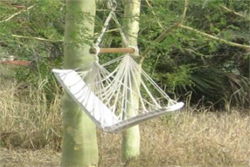 Accommodation Accommodation
Our Camps
Our authentic and utterly unique Explore Gorongosa safari experience
is based from an exclusive seasonal tented eco-camp and a series
of light wilderness fly-camps... Although the trend these days is
for safari camps to provide seventeen imported Mongolian cotton
facecloths per person, delicately soaked in endangered highland
yak milk and served chilled with a skinny moccachino presented in
Italian marble coffee cups with gold inlay... we at Explore Gorongosa
like to think it is more the experience that counts and that, like
the wrapper around a yummy Swiss chocolate, the camp is simply the
outer layer which keeps the whole thing together.
Mixed metaphor's aside, our personal, friendly and conscientious
approach to the authentic African safari experience means we prefer
to focus on what our guests get to feel, see, learn and do, then
on the labels on our frilly bits. The Explore Gorongosa experience
is hosted from our exclusive seasonal tented bush camp - known to
the inner circle as Explorers, or just "Our Camp" - situated
in a beautiful private operational area within the Gorongosa National
Park.
We can also take you out for a night or two at our light wilderness
fly-camps, the Gorongosa SkyBeds, which we set up at a few stunning
sites in and around the Park such as at the Murombodzi waterfalls
and on top of Mount Gorongosa. Whichever way you end up spending
the night, you are of course looked after in the wide-open embrace
of our great team of Mozambican camp hands, with suitable reinforcements
provided by our camp host and our professional safari guide.
Explorers Camp
Featuring a handful of spacious and quirky tented suites, Explorers
is not your average bush camp. In fact, we hope you’ll treat
it as your home away from home, as long as you don't associate televisions,
telephones, newspapers, recessions, screaming kids, broken pool
pumps, high power bills, and the neighbour's annoying yapping dog
with home! No, Explorers is a simple place, a gentle haven of peace
and space; a place based on our keep-it-supremely-friendly-and-simple
recipe.
Each suite has an alfresco 'en tent' bathroom comprising an eco-innovative
waterless loo and a fantastic wash-in-the-wild shower designed to
give you privacy and a feeling of freedom all at the same time.
Enormous king-size doubles or extra-length twin single beds are
available with snug down duvets and cotton linen and towels of highest
quality. One of our main aims in the design of the camp was to have
as much of it home-made as possible, with much of it being sourced
from the region. Apart from the odd bit here and there, we like
to think we have achieved this, right down to Mrs Janisch's home-made
plum jam which, on a loaf of freshly baked pot-bread, goes down
faster than a homesick mole.
The eating, chillaxing and social area of the camp features an
open-air library and lounge, as well as a spacious canvas mess tent
for general...er...mess, when the weather is not too friendly. Dining
takes place pretty much anywhere it is requested with the focus
on excellent taste and even better company. If one wishes to get
away from the high energy pursuits of lounging, dining, sleeping
or abluting, there are hammocks to swing in, trees to climb, and
a campfire to muse over... all in all, Explorers is an experience
within an experience. And that’s the way we intend to keep
it.
Gorongosa SkyBeds
If you have the time and inclination, three, four, seven or seventeen
nights at our camp works quite well with a night out and about using
a light fly-camp sited on secret big-tree-covered spots around our
exclusive operating area within the Park and elsewhere in the region.
This fly-camp - the Gorongosa SkyBeds - is set up in keeping with
the pioneering camps of old, providing very light yet comfortable
temporary accommodation whilst the camp’s inhabitants busy
themselves messing about in the bush. The basics of great food,
cold drinks and hot showers are taken care of by our excellent team.
The "rooms" are actually simple mosquito-gauze bow tents
housing a snug bed complete with down duvet and cotton linen. The
ablutions are a shared hot bucket shower and a waterless eco-loo,
and the dining and lounge area comprises a campfire with some comfy
stools scattered around it... But as quickly as you can say paradise,
you're lying in bed in the middle of a sweeping floodplain, under
a canopy of stars, with only a thin layer of gauze and canvas between
you and... well, heaven really.
When camping on the summit of the Gorongosa Mountain, the Gorongosa
SkyBeds are tailored to suit wet weather through the application
of a light trekking bow tent.
Closed until further
notice




Email for Reservations: book@go.mozbookings.com
Getting There
Getting to Gorongosa has become easier than trying to spell
it! Here are some important details to help you find your way to
Gorongosa National Park. The great news is that our friends at CFA
Charters are now flying scheduled return flights twice weekly (Monday
and Friday - 1h25 flight time over beautiful Mozambican coastline)
directly from Bazaruto Island (Vilanculos) to the landing strip
at Gorongosa National Park (Chitengo - about 20 minutes from our
camp). Added to this, Airlink fly direct flights from Johannesburg
(OR Tambo International) to Beira every day of the week –
only 1 hour 25 minutes in a leather-seated Embraer jet with departure
times out of JHB mid-morning to link up perfectly with overnight
long-haul flights into JHB.
Getting to us by Air
Gorongosa National Park has its own airstrip for light aircraft
at Chitengo Camp with fly-in access from Beira, Chimoio and Vilanculos
(and the surrounding Bazaruto archipelago resorts). Scheduled flights
to Beira from Johannesburg, Harare and Maputo can be booked with
either LAM or Airlink. Regular schedule flights to Chimoio from
Maputo can be booked through LAM, and frequent scheduled flights
to Vilanculos from Johannesburg (and back via Kruger-Mpumulanga)
are available through Pelican Air.
Charter flights into Gorongosa National Park (Chitengo airstrip)
As mentioned above, we soon will have scheduled charters directly
into the Park from Bazaruto Island and Maputo. These flights leave
Bazaruto Island on Monday and Friday mornings and head up the scenic
coastline to Gorongosa – a flight time of about 1h25 from
Bazaruto to Gorongosa. The flights then return the same way. Non-scheduled
charter flights to Chitengo airstrip will depart within 30 minutes
of you clearing customs and immigration at either Vilanculos, Beira
or Chimoio international airports.
However if you arrive in Vilanculos after 14h00 or Beira and Chimoio
after 15h00, you will probably need to overnight in those towns
and be transferred the next morning, unless you are willing to pay
a fee for the plane overnighting in the Park You can fly to Beira
and Chimoio from Maputo via LAM - Mozambique’s national airline.
You can also fly to Beira from Johannesburg with Airlink (part of
South African Airways).
Please be aware that Mozambique has recently adopted a policy of
enforcing Yellow-Fever vaccinations for those travellers originating
from known Yellow-Fever countries. This should not affect most of
our guests but is worth bearing in mind if your trip includes countries
such as Tanzania or those in central Africa. Please check with your
tour operator or agent before travelling. Alternatively, you will
be kindly offered a rather painless jab in the airport in Beira
- but this can be a hindrance so best check beforehand!
LAM fly from Maputo to Durban and Johannesburg, as well as via Harare
to Nairobi and Lilongwe (on code-share with Kenya Airlines). SA
Express also fly from Maputo to Cape Town direct twice a week. TAP
fly direct to and from Maputo out of Lisbon, Portugal, whilst Johannesburg,
Durban and Cape Town are well serviced by international airlines.
Estimated flying times
From Vilanculos/Bazaruto to Chitengo: approximately 60-75 minutes,
depending on airplane type.
From Beira to Chitengo: approximately 35 minutes, depending on airplane
type.
From Chimoio to Chitengo: approximately 20 minutes, depending on
airplane type.
Please be aware that due to the limited space in the small aircraft
used as charter flights into Chitengo, we ask you to please restrict
your luggage to a maximum of 12kg per person, in soft luggage carriers.
Failure to restrict luggage will result either in delayed luggage
arrival or additional costs.
Getting to us by Road
Gorongosa National Park is easily accessible by road off the newly
completed tarred national highway - the EN1 - which is the main
north-south road running the length of Mozambique. The turn-off
for the Park is approximately 30 kilometres north of Inchope, which
is a small village at the junction of the EN1 and the main Beira-Mutare
road, and the last stop for fuel before the Park.
From the well signed turn-off from the EN1, it is a short 11 kilometre
stretch of good gravel road to the main Park gate where Park entry
fees are payable (200 MTN per person and 200 MTN per vehicle). From
here it is a scenic 18 kilometres of very good gravel to Chitengo
Camp (half an hour approximately) where you will be met by your
guide at the Chitengo Camp reception. The Park is accessible by
most high-clearance vehicles.
Park Facilities and Activities
The Park has a long history of providing an incredible setting for
photographic safaris in Mozambique. Despite over two decades of
conflict, much of Gorongosa’s infrastructure remains. The
Park’s original headquarters in the south - Chitengo Camp
- is also a public rest camp, comprising 18 comfortable air-conditioned
cabanas as well as a shady public campsite and Chikalango, Chitengo's
new and improved restaurant serving breakfasts, lunches, and dinners.
There is a swimming pool in the camp - a welcome addition on hot
summer's days! - and the camp is currently able to host conferences
for up to 40 delegates. Currently, Chitengo offers guided game-drives
and village visits although a series of fresh new activity offerings
are in the pipeline.
Seasons
The weather at Gorongosa is - like the Park as a whole - something
of a mystery. There is officially a wet season and a dry season,
the longer latter season encompassing the bulk of the year from
May through to mid-December, with the Park closed to all from late-December
to late-February. However, as we are discovering this year, these
seasons are not entirely rigid and fluctuate somewhat such that
you can have rain in July and dry cold spells in February.
Closed until further
notice





Flora and Fauna
Gorongosa National Park is home to a great diversity of
animals and plants, some of which are found nowhere else in the
world. From the lumbering African elephant to the endemic Green-Headed
Oriole; from the famed Gorongosa lions to the rarely seen fire squirrels
of the rainforest, each species has a story to tell. Soon you will
be able to browse through lists of hundreds of species, to learn
more about the smallest insects to the largest mammals found in
Gorongosa.
Ecology
The ecology and history of the Park is fascinating, and
provides an insight into the more complex socio-ecological aspects
of Mozambique as a whole. Gorongosa National Park protects a diverse
ecosystem that is defined by the life-giving rivers and underground
aquifers that flow into the valley. The heart of Gorongosa, Lake
Urema is an incredible natural phenomenon that is fed from nutrient-rich
aquifers filtering down from hundreds of kilometers away.
These bountiful water sources provide the ideal habitat for a multitide
of wildlife, some found only in this region. Moreover, the ecology
of Gorongosa is unique in that the vegetation varies from open grassy
floodplains, through fever tree forests, palm thickets and mixed
woodland, to Albida forests, Miombo-lined ridges, oxbow lakes and
seaonal sodic pans.
There are deep, bat-filled caverns and gaping limestone gorges;
cascading waterfalls set in threatened cloud forest, and baobab-dotted
broadleaf. As part of the ever-expanding Rift Valley, the Gorongosa
system is constantly in flux, which makes it even more exciting
as a living, breathing ecological treasure. The Gorongosa region
is also situated in a very ecologically diverse setting between
the lower Zambezi and Pungwe/Buzi river and delta systems.
People
A deeper look at the social history and cultural diversity
of the people of Gorongosa provides a fascinating journey through
the history and culture of Mozambique as a whole. Although people
are not allowed to live within the Park, a large number rely on
the Park for their livelihood, whether through fishing, employment,
natural resource harvesting or related activities. Soon you will
be able to learn more about the people who live in the traditional
villages that border the Park.
History
Gorongosa has a rich and fascinating history. Through the
centuries, this region has been on the crossroads of history, a
result of both its geographic position as well as its abundant natural
resources. From ancient civilisations to coastal Arab traders; from
gold, ivory and slave traders of the ancient and recent past to
localised tribal conflicts - central Mozambique’s past is
a microcosm of the history of Africa. Take a walk with us through
some of the origins, the golden years, the harrowing civil war,
and the recovery of Gorongosa National Park.
Although the primary focus of our unique safari experiences within
Gorongosa is the incredible biodiversity of the region, we also
like to introduce our guests to this varied and often quite harrowing
history. This reflection on the past serves as a very important
lesson on the impact of people on the environment and on each other
- a reminder and a cautioning of the effects of our-story on this,
our very fragile planet home.
Closed until further
notice
Email for Reservations: gorongosa@go.mozbookings.com
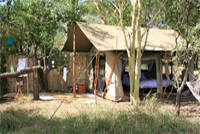
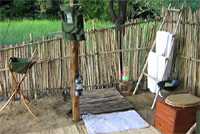
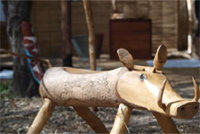
|

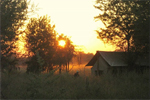
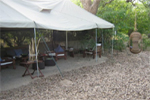
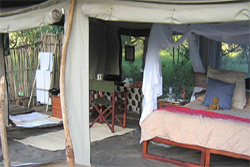 Our
principal offering at Explore Gorongosa is an exclusive tented camp
safari experience, aimed at introducing our guests to the wonders
of the Gorongosa National Park. There are no set itineraries, and
activity and schedule options are entirely flexible.
Our
principal offering at Explore Gorongosa is an exclusive tented camp
safari experience, aimed at introducing our guests to the wonders
of the Gorongosa National Park. There are no set itineraries, and
activity and schedule options are entirely flexible.
 Accommodation
Accommodation










